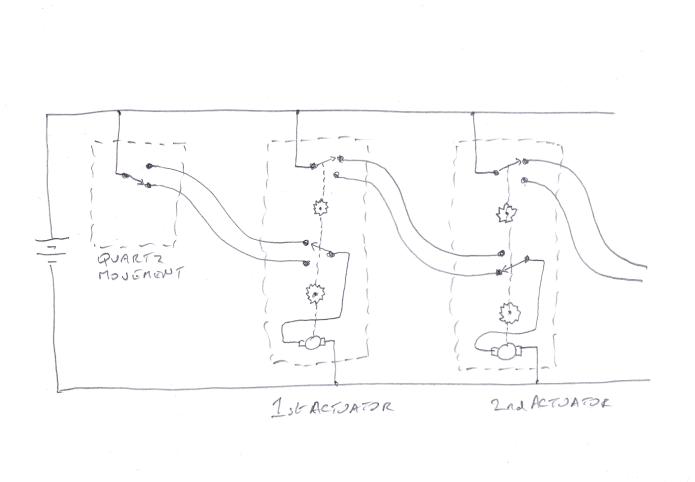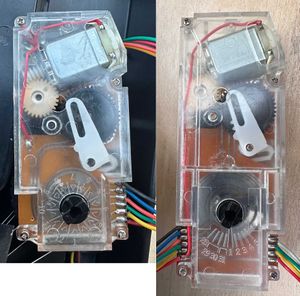How flip clocks work: Difference between revisions
| Line 50: | Line 50: | ||
The reduction gear in this actuator would have a ratio of 30:1, causing the month to change after the 30th day. Manual adjustment is required for months not having 30 days. | The reduction gear in this actuator would have a ratio of 30:1, causing the month to change after the 30th day. Manual adjustment is required for months not having 30 days. | ||
Some flip clocks have a more sophisticated arrangement using rotary switches with multiple contacts instead of microswitches. The day-of-month mechanism is activated at midnight as normal, but this has 3 sets of contacts causing it to advance once normally, but twice on the 30th of April, June, September and November, and four times on the 28th of February. Manual adjustment is then only needed in February of a leap year. | [[File:Flip-clockMechanism.jpg|thumb|right|The day of month and month mechnisms of a more sophisticated flip clock.]] | ||
Some flip clocks have a more sophisticated arrangement using rotary switches with multiple contacts instead of microswitches. The day-of-month mechanism is activated at midnight as normal, but this has 3 sets of contacts. One of the 3 is energised according to the month by the month mechanism, causing it to advance once normally, but twice on the 30th of April, June, September and November, and four times on the 28th of February. Manual adjustment is then only needed in February of a leap year. | |||
For a flip-clock which isn't working, careful examination of the mechanism will be required in order to understand why. You may be able to flip the switches manually in order to test individual stages. A manual setting button may make this easy. If just one of the mechanisms is failing to operate reliably, that's obviously where you will need to look. If just the first few work then maybe the battery is fading after turning these, to the extent that it no longer has the power to turn the remaining ones simultaneously. | |||
==External Links== | ==External Links== | ||
Revision as of 16:15, 28 October 2023
Old fashioned digital flip clocks display digits on flip-down leaves. The mechanisms are described in this page.
Old fashioned digital flip clocks display digits on flip-down leaves. The mechanisms are described in this page.
Summary
The earliest form of digital clock displayed the digits (Hours and minutes, and possibly days or the week and months), with each split into top and bottom halves of adjacent leaves in a pack, as in this animation. They were electromechanical devices with ingenious mechanisms. Clocks of this type are brought into Restart Parties from time to time as cherished legacy items, or treasured finds from a car boot sale or similar. An understanding of how they work helps greatly in any repair situation.
Safety
- Old mains powered devices may have worn or perished insulation on the mains lead, creating a serious shock or fire hazard. In the oldest devices, the design may be inherently unsafe, for example having exposed metal parts without a safety earth connection.
The Timepiece
Older clocks normally have a mains-driven synchronous motor, locked to the frequency of the AC mains supply. (The mains frequency is guaranteed to be stable over a 24 hour period, though it may vary slightly over the course of a day). In a very old example, if there are concerns over its electrical safety or if the coil appears to be open circuit, this website describes various options, including how to convert it to inherently safe low voltage operation.
If the motor isn't turning even though the coil is definitely not open circuit, then the motor spindle or gears may need cleaning and lubrication. Excessive wear of the bearings may cause the gears to jam, which would be challenging to rectify.
Newer examples may have a standard quartz or radio-controlled timepiece. There are some clocks branded Karlsson or Habitat (probably rebranded Karlsson) having a quartz movement driving a conventional analogue time display. The flip display just displays the date.
In the case of a quartz or radio controlled movement, first check that the battery is good, and that it is a good quality alkaline type. A zinc type may not be powerful enough, and a rechargeable type may not supply sufficient voltage. Repair options are limited, and whilst replacement quartz clock movements are readily available online, it may be harder to find one containing the switch required to activate the flip mechanism.
The Flip Mechanism
Purely Mechanical
Many flip-clocks have the flip wheels in-line, and like the digits of a mechanical odometer in a car, one complete rotation of each wheel triggers a flip of the next digit. This will take more force than a flip of a single digit, and the most force will be required at midnight when the minutes, hours and day are all changing together.
Such a mechanism is purely mechanical, and any repair will require you to understand what is hindering the correct operation, whether it be a need of cleaning and lubrication, or the result of wear.
Electromechanical
Karlsson, Habitat and possibly other similar flip clocks have a quartz analogue time display, and separate electro-mechanical flip mechanisms for the day of week, day of month, month and year. These are all driven by separate electric motors and are linked electrically rather than mechanically.
The motors in the flip mechanisms require a relatively heavy current to operate and so will use large size batteries. These need to be good quality alkaline types.
In the Karlsson and Habitat clocks, each flip mechanism triggers the next by means of a 2-way switch, the same circuit as is frequently used to allow a landing light to be turned on or off equally by one switch at the bottom of the stairs and another at the top. This uses the very simple circuit in the diagram.
Note that a current can only flow and light the lamp if both switches are in the same position. Switching either switch will turn the light on if it's off, or off if it's on.
The sketch below shows two stages of an electromechanical flip clock. This assumes the quattz movement displays analogue time of day and the first two flip mechanisms display am/pm and day of month. A third (not shown) might display the month.
At 12:00 (am or pm), a 2-way switch in the quartz movement is flipped into its opposite position. This completes the circuit to the motor which drives the first flip wheel via a reduction gear. The motor runs until the display has flipped, at which point a 2-way switch in this actuator is flipped into its other position, breaking the circuit and stopping the motor. Next time at 12:00 the same happens except that the switches return, one after the other, to their original posistions.
A further 2:1 reduction gear in this actuator operates a second 2-way switch connected to the next actuator. Thus, whenever the first flip display changes from pm to am (at midnight), the motor in the second actuator is activated, to flip the day of month display.
The reduction gear in this actuator would have a ratio of 30:1, causing the month to change after the 30th day. Manual adjustment is required for months not having 30 days.
Some flip clocks have a more sophisticated arrangement using rotary switches with multiple contacts instead of microswitches. The day-of-month mechanism is activated at midnight as normal, but this has 3 sets of contacts. One of the 3 is energised according to the month by the month mechanism, causing it to advance once normally, but twice on the 30th of April, June, September and November, and four times on the 28th of February. Manual adjustment is then only needed in February of a leap year.
For a flip-clock which isn't working, careful examination of the mechanism will be required in order to understand why. You may be able to flip the switches manually in order to test individual stages. A manual setting button may make this easy. If just one of the mechanisms is failing to operate reliably, that's obviously where you will need to look. If just the first few work then maybe the battery is fading after turning these, to the extent that it no longer has the power to turn the remaining ones simultaneously.
External Links
- FlipClockFans.com - Discussion forums and a wealth of nformation on flip clocks.




